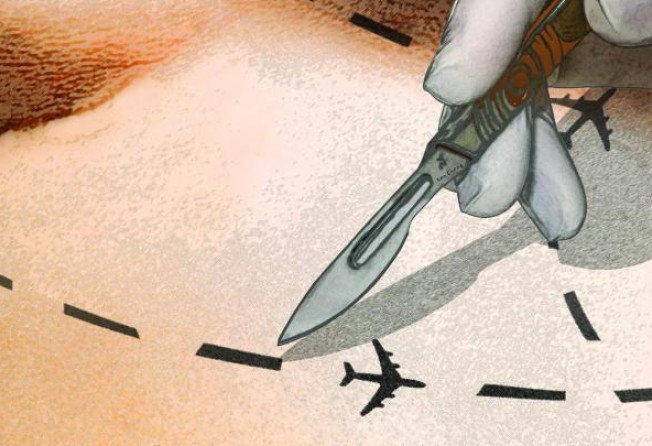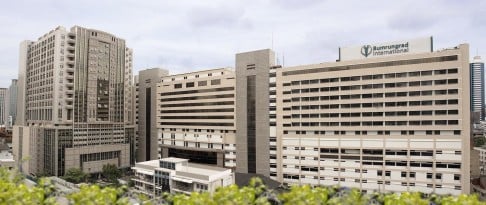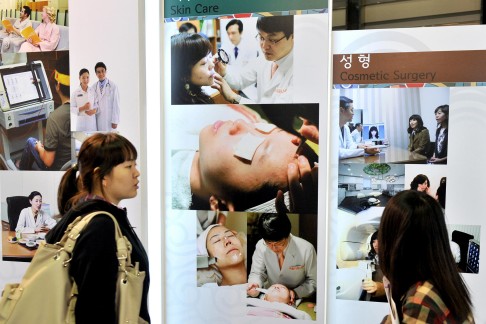The rise of medical tourism: buyer beware
Medical tourism is booming, but patients should do their research before committing to procedures, writes Elaine Yau

Hong Kong-based writer Monica (not her real name) managed to shed serious weight following a stomach bypass operation in India five years ago.
But this left loose skin on her stomach and arms, so she returned to India last year to trim off the excess. Her attempt at body contouring, however, turned into a nightmare.
"My stomach bypass in New Delhi wasn't optimal, but it wasn't bad and didn't put me off, obviously. But the one for excess skin, done in another part of India, turned into a horror fest," she says. "The worst thing was, they woke me up early while the doctor was still closing the wound. Luckily, as I was pumped with painkillers, I didn't feel pain.
"But I still had the tube down my throat. Because it goes past your swallow reflex, you think you are choking. You can't move because you get muscle relaxants. But I clearly remember they put metal staples on my arm, and I could hear the stapler. I felt the guy holding my arm. I tried to show him I was awake. But I couldn't.
"They only knew I was awake afterwards because I told them. If this happened in Hong Kong, I could sue them, and the doctor would face action. But I had nobody to complain to in India. I became traumatised by it."
Monica's experience illustrates some of the risks patients face when they seek treatment abroad, usually at facilities where fees are significantly lower than those at home. These are the "medical travellers".
It's a growing, lucrative segment. According to a study by market researcher Global Information of six regional hotspots for medical tourism - India, Malaysia, the Philippines, Thailand, Singapore and South Korea - the industry in Asia is expected to grow to US$8.5 billion this year (see below).
Hong Kong also has tried to position itself as a destination for medical services since 2007 (though somewhat unhappily when it embraced mainland birth tourism).
As private health care costs escalate in Hong Kong amid long waits for treatment at public facilities, more people are pursuing cross-border options for a range of procedures. Most are drawn to nearby countries that can offer equivalent treatment at a fraction of the cost here. Others go abroad to circumvent Hong Kong's strict rules on certain procedures.
For Tina Fong, 31, the treatment was gender-specific artificial insemination, which is illegal here. "My husband has three sons by his ex-wife, so he really wanted to have a daughter," says Fong. "There are only a handful of countries like the US, South Africa and the Middle East where the process is legal. Thailand was the nearest destination for us. I did the treatment in a private clinic in Bangkok. It cost HK$35,000, and I stayed in Thailand for two weeks. I got pregnant, and my daughter was born in December 2010."
While leading hospitals in destination countries may boast cutting-edge equipment and highly trained doctors, patients must contend with such issues as a lack of legal recourse should complications arise.
Union Hospital medical director Dr Anthony Lee Kai-yiu urges patients to think twice before seeking high-risk procedures abroad.
"It's better to have a check-up outside Hong Kong and then come back for treatment. Complications from surgeries may not arise during or soon after the procedure, so the doctor might not know about them. When problems emerge a few days after discharge, the patient might already be in mid-air.
"If [patients getting cardiovascular operations] don't recuperate for long enough before they get on a plane, the lower air pressure and oxygen levels may have an adverse effect on their weakened bodies," says Lee, who is also chairman of the Private Hospitals Association.
"A local patient can complain to the Medical Council here if doctors make a mistake. But if something goes wrong overseas, the patient can feel helpless. Seeking reparations can be complicated due to differences in legal and medical systems."
Lee also cites issues such as the quality of drugs in countries such as India, where generic medicines are widely used.
He visited a Thai hospital a few years ago, and found the facilities to be superb. But he reckoned its claims about a high proportion of staff having overseas training did not stand up to scrutiny.
"The more usual case is that the leading doctors have overseas training, but those below them are trained locally. Those hospitals adopt an assembly-line approach to treating patients. Medical devices like stents for angioplasty are often made in China, and can have quality control problems," he says.
"Differences in diagnostic criteria are another concern. A local doctor would rule out surgery for a patient whose artery is 50 or 60 per cent blocked, because the condition can be improved through lifestyle changes or medicine. But Southeast Asian doctors who want to boost their caseload will opt for surgery."
But at Bumrungrad International in Bangkok, the largest private hospital in Southeast Asia, marketing director Kenneth Mays says lower salaries, living costs and market forces keep costs down.
"We offer a Mercedes product at a Toyota price," Mays says. "There are 100 hospitals in Bangkok alone. The majority of patients are Thai. About 75 per cent of our revenue is self-paid, which means patients pay out of their own pockets, and they will go somewhere else if they are not OK with the service.
"We charge Thai and foreign patients the same. International patients benefit from the competitive medical structure in Thailand. We don't run patients through assembly lines."
Many seem to agree. Bumrungrad recently opened an 18-storey outpatient centre, doubling its capacity for non-residential treatment to 6,000 people per day.
Check-ups are among the popular services, along with anti-ageing medicine, cardiology, gastroenterology and plastic surgery, says Mays. "For elective treatments [such as plastic surgery] not covered by insurance in Hong Kong, we are 30 per cent cheaper than the [Hong Kong] Sanatorium."
A latecomer to medical tourism, Malaysia is fast catching up with the leading players such as Singapore. Last month, it opened an office here (in addition to Jakarta and Dhaka) to help prospective patients.
Mary Wong Lai-lin, chief executive officer of the Malaysia Healthcare Travel Council, says that while Thailand introduced medical tourism 30 years ago, Malaysia introduced medical tourism about four years ago. The number of international patients visiting the country has risen from 330,000 in 2009 to 583,000 last year.
Wong expects the number of Hong Kong patients to balloon to 10,000 in five years' time from the current 1,000, pointing to significantly lower medical fees and widespread use of Cantonese in Malaysia as major draws.
"You may not even need an interpreter; 30 per cent of the population in Malaysia is of Chinese origin," she says. Moreover, "hospitals involved in medical tourism can get 100 per cent tax allowance for capital expenditure on medical equipment. So the cost of advanced equipment won't be transferred to customers."
The greater leeway in Malaysia for experimental treatments such those involving stem cells is another attraction for medical tourists, Wong says.
HSC Medical Centre in Kuala Lumpur, for instance, used stem cells to grow cells in the dying heart muscles of patients facing cardiac failure three years ago.
"Stem cell treatment is still in the experimental stages but we are very selective and careful. Only four companies are licensed by the Ministry of Health to provide stem cell services here," says HSC chairman Dr Lim Yin Chow.
However, slick websites displaying advanced medical set-ups and listing impressive panels of staff can be misleading. As Monica discovered after paying a deposit, the Indian facility she signed with wasn't even a hospital.
"After paying the deposit, I kept telling them I was diabetic. Because of the scale of the operation, there's a possibility of me going into shock and there's a death risk. I have to stay in a hospital because I need the equipment in case something goes wrong. I kept asking whether they were a hospital and they just kept stalling ... After I arrived, I found out it was just a clinic with an operating theatre."
At the Hong Kong Sanatorium & Hospital, Dr John Chang So-min, director of its Guy Hugh Chan Refractive Surgery Centre, says language differences can affect treatment, noting that local ophthalmologists have treated a number of Hongkongers for botched eye surgeries on the mainland and in Thailand.
Procedures to correct sight problems using Lasik machines are done while the patient is conscious, he says. "The doctor needs to tell the patient which light to look at during surgery. Some patients get frightened and we need to calm them and keep reminding them to keep their eye still. Such back-and-forth should be conducted in the mother tongue."
Chang adds that quality of treatment may suffer when centres pursue more international patients to make up for lower fees. For instance, some places are able to charge less for laser eye surgeries because they run their equipment at full capacity to treat more patients.
"Running machines at full capacity is not a good thing, as doctors need to personally tune the machines between patient sessions," Chang says.
Sterile conditions can also be a concern. Chang says: "They might reuse medical equipment that is meant to be disposed of instantly after use, and this can lead to inflammation in patients."
Monica, too, found her wounds became infected after her return.
"All stitches were rejected by my body. It ended up being really messy. It's quite scary. I thought I would be scarred for life as the wounds were really deep."
She eventually sought help from St Paul's Hospital here. Doctors traced the infection to a bacterium although they could not be sure if it was picked up during her surgery or something already existing in her body. And the extended course of antibiotics added up to "a huge bill".
Despite higher risks and some horror stories, the significant savings are likely to lure more Hong Kong patients overseas.
Monica, for one, still plans to go back to India to remove the excess skin on her legs.
She paid about HK$70,000 for her two procedures in India, but it would have been much more expensive if she had them done in Hong Kong. What's more, the stomach bypass she had in 2008 was not available here at the time.
"I may not go back to that hospital, but I might go to another one in India," she says.
6 medical tourist hotspots are just what the doctor ordered
Josef Woodman, author of medical tourism guidebook Patients Beyond Borders, estimates there are about seven million people worldwide who travel abroad for treatment. Here are some of the top Asian destinations.
India
The country is known for high-volume and speedy operations.
The Aravind Eye Care System, the world's largest provider of eye surgeries, does more than 300,000 surgeries a year - almost 7 per cent of the global total - and surgery happens every 15 minutes. Narayana Hrudayalaya in Bangalore, the world's largest heart hospital which specialises in children's congenital diseases, performs more than 50 surgeries a day. Open-heart surgery can cost as little as as US$2,000. The Apollo Group, which runs 50 hospitals, is another popular choice.
Malaysia
Seventy-two out of 253 private hospitals in Malaysia are open to medical travellers. Popular travel packages include exams such as colonoscopy and coronary angiogram.
Dr Lim Yin Chow, chairman of the HSC Medical Centre in Kuala Lumpur, reckons the facility attracts patients from Hong Kong's sandwich class.
They seek heart treatments like angioplasty and stenting, which done on a day-care basis, allowing them can fly back to Hong Kong the next morning, Lim says.
Experimental treatments are another attraction. Three years ago, HSC provided stem-cell therapy for a few heart disease patients after conventional medicine failed.
Singapore
Hospitals in Singapore target high-end patients looking for specialised services. The recently opened Fortis Colorectal Hospital, for one, is the only facility in Southeast Asia focused on colorectal diseases. Other hospitals offer diving medicine and hyperbaric oxygen therapy.
South Korea
Dubbed the plastic surgery capital of the world, Seoul charges are lower than in Hong Kong and the West. Eyelid surgery and nose jobs (rhinoplasty) are popular.
Taiwan
Facilities such as Wan Fang Hospital offer check-up packages with China Airlines.
The government promotes five main services: liver transplant, plastic surgery, artificial insemination, cardiovascular treatment and joint replacement. Chang Gung Memorial Hospital is known for reconstructive surgery.
Thailand
Bumrungrad International, Samitivej Hospital and Bangkok Hospital boast hotel-style settings and cutting-edge medical equipment. All three are accredited by the US-based Joint Commission International. Some hospitals have centres for cosmetic surgery, neurology, urology, and fertility treatment.

